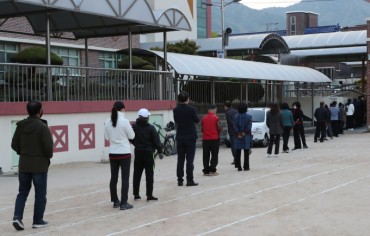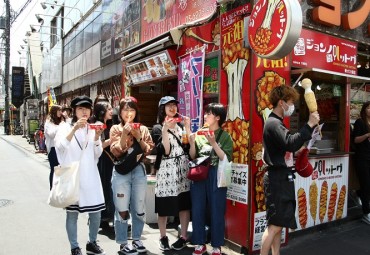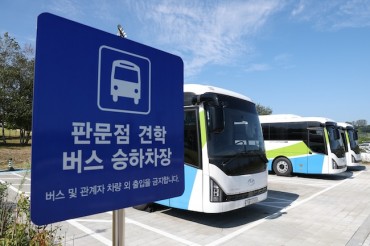
This photo, released on Feb. 9, 2023, by North Korea’s official Korean Central News Agency, shows weapons being showcased at a major military parade in Pyongyang. (Yonhap)
SEOUL, Feb. 16 (Korea Bizwire) — South Korea’s defense ministry has referred to the North Korean regime and military as an “enemy” in its new white paper, for the first time in six years, according to officials Thursday, apparently in consideration of the North’s evolving nuclear and missile threats.
In the 2022 Defense White Paper, the ministry also described Japan as a “close neighbor” in line with Seoul’s move to improve bilateral security ties and offered a new assessment on Pyongyang’s growing stockpile of plutonium, a fissile material used to build nuclear bombs.
It marks the first biennial defense policy document published under the conservative Yoon Suk Yeol administration launched in May last year.
Yoon took office with a pledge to get tough on North Korean provocations and achieve “peace through strength.”
“As the North defined us as an ‘undoubted enemy’ at the plenary meeting of the ruling party’s Central Committee in December 2022, and continues to pose a military threat without renouncing its nuclear program, the North Korean regime and military — the executor of that (threat) — are our enemy,” it reads.
The South called the North’s military an “enemy” in the white paper in 1995 after a Pyongyang official threatened to turn Seoul into a “sea of flames.”
In the 2004 version, the expression was replaced by a “direct military threat” amid a conciliatory mood.
The labeling was reinstated in 2010 as the North torpedoed a South Korean corvette in March of that year, killing 46 sailors, and launched an artillery attack on a border island in November, killing two soldiers and two civilians. The expression stayed until the 2016 edition.
But the description disappeared in the 2018 and 2020 editions issued under the then liberal Moon Jae-in administration that tried notably to promote inter-Korean reconciliation.
In an apparent reflection of the strained cross-border ties, the latest document called the North Korean leader just by his name, Kim Jong-un. The previous edition referred to him as the State Affairs Commission chairman.
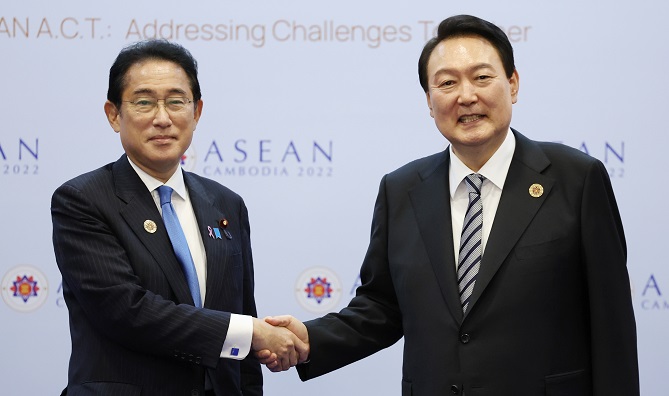
This photo, taken on Nov. 13, 2022, shows President Yoon Suk Yeol (R) shaking hands with Japanese Prime Minister Fumio Kishida prior to their talks on the margins of regional gatherings in Cambodia. (Yonhap)
In its reference to Japan, the latest document used the expression “close neighbor” for the first time since the 2018 edition.
“ROK and Japan share values, and Japan is a close neighboring country that (ROK should cooperate with to) build future cooperative relations that serve common interests,” it reads.
ROK stands for South Korea’s official name, the Republic of Korea.
In the previous version, Japan was described as a “neighboring country that the ROK should cooperate not only for bilateral relations but also for peace and prosperity in Northeast Asia and the world.”
The 2018 edition referred to the two countries as “geographically and culturally close neighbors as well as partners cooperating for global peace and prosperity.”
Touching on the North’s nuclear activities, the 2022 document assessed the North possesses some 70 kilograms of plutonium, up from 50 kg estimated in the previous document.
Around 6 kg of plutonium is required to build a single nuclear bomb.
The increase appears to be attributable to the operation of a key plutonium-producing nuclear reactor and other activities at the North’s mainstay nuclear complex in Yongbyon, north of Pyongyang, according to observers.
A 2021 report from the International Atomic Energy Agency indicated the 5-megawatt reactor at the complex showed signs of being in operation since July 2021.
It also said a steam plant, used to provide heat to a reprocessing facility, had been operated for around five months since February of the same year.
The white paper also described the amount of the North’s highly enriched uranium (HEU) as “considerable.” The production of one nuclear bomb requires 15 kg to 20 kg of HEU.

A Hwasong-17 intercontinental ballistic missile (ICBM) is launched from Pyongyang International Airport on March 24, 2022, in this photo released by North Korea’s official Korean Central News Agency. (Yonhap)
The white paper included a series of new North Korean missiles, including the Hwasong-17 intercontinental ballistic missile (ICBM) and tactical short-range missiles, in an analysis of the country’s growing arms list.
In particular, it highlighted the North’s consistent push to develop solid-propellant ballistic missiles with greater accuracy and improved capabilities to avoid interception.
“North Korea has continued the test-firing of solid-propellant ballistic missiles, which are more advantageous than liquid-fuel ballistic missiles in terms of their operational employment,” the document said.
On the North’s ICBM atmospheric reentry technology, the white paper stressed the need for further analysis, noting the country’s past ICBM launches were conducted on a lofted trajectory rather than on a standard one.
Highlighting the South’s deterrence efforts in multiple pages, the white paper detailed its push to secure capabilities for the “three-axis” military system.
The three-pronged system consists of the Korea Massive Punishment and Retaliation (KMPR), an operational plan to incapacitate the North Korean leadership in a major conflict; the Kill Chain preemptive strike platform; and the Korea Air and Missile Defense system.
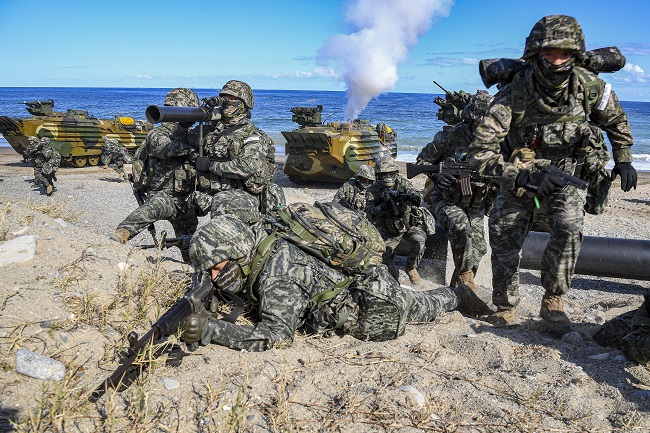
Troops secure a target area during the military’s amphibious landing drills at a coastal area in Pohang, 272 kilometers southeast of Seoul, on Oct. 26, 2022, in this photo provided by the Marine Corps.
The new document also compared the troop strengths of the two Koreas.
It put the number of South Korean active-duty personnel at around 500,000, down from 555,000 tallied two years ago. The figure for the North stood at 1.28 million, the same figure recorded in the 2018 and 2020 white papers.
The South has been pushing for a nimbler yet smarter military based on cutting-edge technologies amid prospects of personnel shortages caused by the country’s falling birthrate.
The document also said the South has about 2,200 tanks, 90 surface combatant ships and 10 submarines, while the corresponding figures for the North were around 4,300, 420 and 70, respectively.
The document stressed the numerical data was based only on “quantitative” comparisons, and that a more detailed analysis of assets’ capabilities, their deterioration, the level of training and operational concepts would make a “difference” in the military strength assessment.
In an appendix, the ministry spelled out key North Korean violations of a 2018 inter-Korean military agreement aimed at reducing border tensions and preventing accidental clashes, while it stated in the 2020 edition that Pyongyang was “generally” complying with the agreement.
The ministry plans to publish the white paper in English, Japanese, Chinese and Russian in the first half of this year. The Korean-language version will be downloadable from the ministry’s homepage, starting this afternoon.
(Yonhap)




